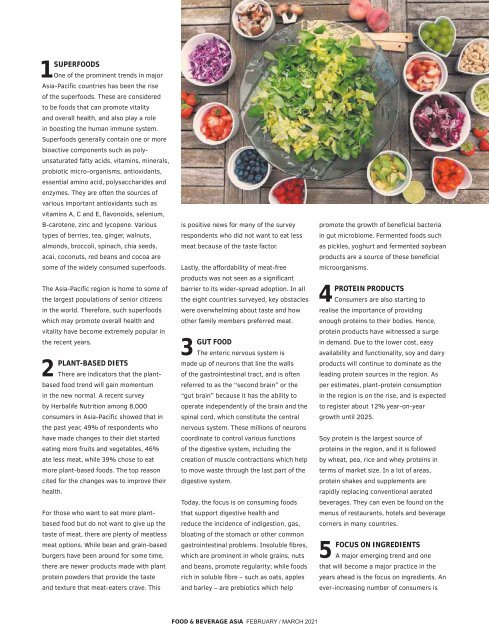Food & Beverage Asia February/March 2021
Food & Beverage Asia (FBA) is the leading source of food and beverage news in Asia since 2002. FBA delivers a comprehensive view of the food and beverage landscape, spanning across the latest health and nutrition trends and industry innovations in ingredients, recipe formulations, food science, sustainability, packaging, and automation, as well as advancements in agri and food-tech.
Food & Beverage Asia (FBA) is the leading source of food and beverage news in Asia since 2002. FBA delivers a comprehensive view of the food and beverage landscape, spanning across the latest health and nutrition trends and industry innovations in ingredients, recipe formulations, food science, sustainability, packaging, and automation, as well as advancements in agri and food-tech.
You also want an ePaper? Increase the reach of your titles
YUMPU automatically turns print PDFs into web optimized ePapers that Google loves.
1 SUPERFOODS<br />
One of the prominent trends in major<br />
<strong>Asia</strong>-Pacific countries has been the rise<br />
of the superfoods. These are considered<br />
to be foods that can promote vitality<br />
and overall health, and also play a role<br />
in boosting the human immune system.<br />
Superfoods generally contain one or more<br />
bioactive components such as polyunsaturated<br />
fatty acids, vitamins, minerals,<br />
probiotic micro-organisms, antioxidants,<br />
essential amino acid, polysaccharides and<br />
enzymes. They are often the sources of<br />
various important antioxidants such as<br />
vitamins A, C and E, flavonoids, selenium,<br />
B-carotene, zinc and lycopene. Various<br />
types of berries, tea, ginger, walnuts,<br />
almonds, broccoli, spinach, chia seeds,<br />
acai, coconuts, red beans and cocoa are<br />
some of the widely consumed superfoods.<br />
The <strong>Asia</strong>-Pacific region is home to some of<br />
the largest populations of senior citizens<br />
in the world. Therefore, such superfoods<br />
which may promote overall health and<br />
vitality have become extremely popular in<br />
the recent years.<br />
2<br />
PLANT-BASED DIETS<br />
There are indicators that the plantbased<br />
food trend will gain momentum<br />
in the new normal. A recent survey<br />
by Herbalife Nutrition among 8,000<br />
consumers in <strong>Asia</strong>-Pacific showed that in<br />
the past year, 49% of respondents who<br />
have made changes to their diet started<br />
eating more fruits and vegetables, 46%<br />
ate less meat, while 39% chose to eat<br />
more plant-based foods. The top reason<br />
cited for the changes was to improve their<br />
health.<br />
For those who want to eat more plantbased<br />
food but do not want to give up the<br />
taste of meat, there are plenty of meatless<br />
meat options. While bean and grain-based<br />
burgers have been around for some time,<br />
there are newer products made with plant<br />
protein powders that provide the taste<br />
and texture that meat-eaters crave. This<br />
is positive news for many of the survey<br />
respondents who did not want to eat less<br />
meat because of the taste factor.<br />
Lastly, the affordability of meat-free<br />
products was not seen as a significant<br />
barrier to its wider-spread adoption. In all<br />
the eight countries surveyed, key obstacles<br />
were overwhelming about taste and how<br />
other family members preferred meat.<br />
3<br />
GUT FOOD<br />
The enteric nervous system is<br />
made up of neurons that line the walls<br />
of the gastrointestinal tract, and is often<br />
referred to as the “second brain” or the<br />
“gut brain” because it has the ability to<br />
operate independently of the brain and the<br />
spinal cord, which constitute the central<br />
nervous system. These millions of neurons<br />
coordinate to control various functions<br />
of the digestive system, including the<br />
creation of muscle contractions which help<br />
to move waste through the last part of the<br />
digestive system.<br />
Today, the focus is on consuming foods<br />
that support digestive health and<br />
reduce the incidence of indigestion, gas,<br />
bloating of the stomach or other common<br />
gastrointestinal problems. Insoluble fibres,<br />
which are prominent in whole grains, nuts<br />
and beans, promote regularity; while foods<br />
rich in soluble fibre – such as oats, apples<br />
and barley – are prebiotics which help<br />
promote the growth of beneficial bacteria<br />
in gut microbiome. Fermented foods such<br />
as pickles, yoghurt and fermented soybean<br />
products are a source of these beneficial<br />
microorganisms.<br />
PROTEIN PRODUCTS<br />
4 Consumers are also starting to<br />
realise the importance of providing<br />
enough proteins to their bodies. Hence,<br />
protein products have witnessed a surge<br />
in demand. Due to the lower cost, easy<br />
availability and functionality, soy and dairy<br />
products will continue to dominate as the<br />
leading protein sources in the region. As<br />
per estimates, plant-protein consumption<br />
in the region is on the rise, and is expected<br />
to register about 12% year-on-year<br />
growth until 2025.<br />
Soy protein is the largest source of<br />
proteins in the region, and it is followed<br />
by wheat, pea, rice and whey proteins in<br />
terms of market size. In a lot of areas,<br />
protein shakes and supplements are<br />
rapidly replacing conventional aerated<br />
beverages. They can even be found on the<br />
menus of restaurants, hotels and beverage<br />
corners in many countries.<br />
5<br />
FOCUS ON INGREDIENTS<br />
A major emerging trend and one<br />
that will become a major practice in the<br />
years ahead is the focus on ingredients. An<br />
ever-increasing number of consumers is<br />
FOOD & BEVERAGE ASIA FEBRUARY / MARCH <strong>2021</strong>


















